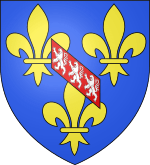Bourbon-Vendôme
| House of Bourbon-Vendôme | |
|---|---|
 | |
| Country | France |
| Parent house | House of Bourbon-La Marche |
| Titles | |
| Founded | 1393 |
| Founder | Louis, Count of Vendôme |
| House of Bourbon-Vendôme (Légitimé de France) | |
|---|---|
 | |
| Country | France |
| Parent house | House of Bourbon-Vendôme |
| Titles | |
| Founded | 1595 |
| Founder | César de Bourbon, Duke of Vendôme |
| Dissolution | 1727 |
The House of Bourbon-Vendôme referred to two branches of the House of Bourbon. The first House of Bourbon-Vendôme was descended from Louis, Count of Vendôme (1376 – 1446), a cadet of the House of Bourbon-La Marche. Though a younger son, Louis was fortunate enough to receive Vendôme through his mother. Vendôme was raised to a duchy-peerage in 1515 in favor of Charles de Bourbon. By 1527, Charles had outlived the Dukes of Alençon and Bourbon, and became First Prince of the Blood. Charles' son Antoine became King of Navarre by marriage; his grandson Henry outlived the House of Valois in 1589, and succeeded to the French throne as the first of the Bourbon kings.
The second House of Bourbon-Vendôme descended directly from the first house. It was founded by César de Bourbon (1594–1665), the legitimized son of King Henry IV of France and his mistress, Gabrielle d'Estrées.
History
Born in 1594, César de Bourbon was legitimised, and created Duke of Vendôme by his father, the king, in 1598. The title of Duke of Vendôme was chosen because it had been held by Henry IV's family prior to their accession to the French throne. After the creation of 1598, the title continued to be used by César de Bourbon's family for over a century.
In 1599, César de Bourbon also inherited the titles of Duke of Beaufort and Duke of Étampes upon the death of his mother. After César de Bourbon's death in 1665, he was succeeded as Duke of Vendôme by his first son Louis (1612–1669), while the title of Duke of Beaufort passed to his second son François (1616–1669).
After the death of the 4th Duke of Vendôme in 1727, the title reverted to the Crown. It continued to be used as a courtesy title by the Comte de Provence, the younger brother of Louis XVI.
Genealogy
- César de Bourbon, 1st Duke of Vendome, 2nd Duke of Beaufort (1594–1665). In 1608, he married Françoise de Lorraine, duchesse de Mercœur et de Penthièvre (1592–1669), daughter and heiress of Philippe Emmanuel, Duke of Mercœur, a rival of his father Henry IV's. They had three children.
- Louis II de Bourbon-Vendôme, 2nd Duke of Vendôme (1612–1669). He married Laura Mancini, niece of Cardinal Mazarin, and had three children.
- Louis Joseph de Bourbon-Vendôme, 3rd Duke of Vendôme (1654–1712). He was appointed Marshal of France. He married Marie Anne de Condé (1678–1718), a daughter of Henry III Jules de Bourbon, prince de Condé and granddaughter of Le Grand Condé. They had no children. After his death, the titles passed to his younger brother, Philippe.
- Philippe de Bourbon-Vendôme, 4th Duke of Vendôme (1655–1727), called le prieur de Vendôme. A Grand Prior for France in the Order of Malta, he was also a French army commander. He held the title until his death in 1727.
- Jules César (1657–1660)
- Elisabeth, Mlle de Vendôme (1614–1664), who married Charles Amadeus of Savoy, 6th Duke of Nemours.
- François de Bourbon-Vendôme, 1st Duke of Beaufort (1616–1669), who never married and had no children.
- Louis II de Bourbon-Vendôme, 2nd Duke of Vendôme (1612–1669). He married Laura Mancini, niece of Cardinal Mazarin, and had three children.
Gallery
.jpg) César de Vendôme: the head and founder
César de Vendôme: the head and founder- Louis Joseph de Bourbon, the Duke of Vendôme on campaign, 1706.
Ancestry
| 8. Charles de Bourbon | |||||||||||||
| 4. Antoine of Navarre | |||||||||||||
| 9. Françoise of Alençon | |||||||||||||
| 2. Henry IV of France | |||||||||||||
| 10. Henry II of Navarre | |||||||||||||
| 5. Jeanne III of Navarre | |||||||||||||
| 11. Marguerite of Angoulême | |||||||||||||
| 1. House of Bourbon-Vendôme | |||||||||||||
| 12. Jean d'Estrees | |||||||||||||
| 6. Antoine d'Estrées, marquis de Cœuvres | |||||||||||||
| 13. - | |||||||||||||
| 3. Gabrielle d'Estrées | |||||||||||||
| 14. - | |||||||||||||
| 7. Françoise Babou | |||||||||||||
| 15. - | |||||||||||||
Other Illegitimate Houses
- Bourbon-Penthièvre - extinct
- Bourbon du Maine - extinct
- Bourbon-Busset